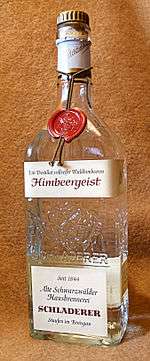Schnapps

Schnapps (/ʃnɑːps/ or /ʃnæps/) is a term for a family of alcoholic beverages that may take several forms, including distilled fruit brandies, [1] herbal liqueurs, infusions, and inexpensive "flavored liqueurs" made by adding fruit syrups, spices, or artificial flavorings to neutral grain spirits.
The English word "schnapps" is derived from the German Schnaps [ʃnaps] (plural: Schnäpse),[2][3] a Low German noun meaning "swallow" documented in High German meaning since before the 18th century.[4]
European
The German term Schnaps refers to any kind of strong alcoholic drink, similar to how eau de vie (water of life) is used in French, or aguardiente (burning water) in Spanish.
Fruit

In Austria, Switzerland, southern Germany, and the French region of Alsace, a type of schnapps called Obstler or Obstbrand (from the German Obst, fruit)[5] is very popular. Obstler, which are fruit brandies, are mainly associated with the southern part of the German-language area. In northern Germany, almost all traditional distilled beverages are grain-based.
The main kinds of fruit used for German schnapps are apples, pears, plums, cherries, and apricots. Fruits other than these five are rarely used. Apples are used along with pears to make Obstwasser (fruit water); pears are used to produce Poire Williams (Williamsbirne, William's pear); several types of plums make Zwetschgenwasser (plum water); cherries make Kirschwasser (cherry water); and apricots are used to make Austrian Marillenschnaps (apricot brandy).
A raspberry-flavored spirit called Himbeergeist (raspberry spirit) is also a referred to as schnapps, although it is not a Obstler. Instead, it is an infusion of fresh berries in neutral spirits,[6][7] which steeped for several weeks before being distilled.
The different kinds of Obstler are similar to the varieties of Rakija found in the Balkans and Eastern Europe. Slivovitz is a popular schnapps made from Damson plums found throughout the region.
Herb
Kräuterlikör (herbal liqueur) is another popular form of schnapps, often sweetened. Well known brands include Jägermeister, Underberg, Kuemmerling, Killepitsch and Wurzelpeter.
American
An inexpensive heavily sweetened form of liqueur[8] is made in America by mixing neutral grain spirit with fruit syrup, spices, or other flavors. Referred to as "schnapps", these are bottled with an alcohol content typically between 15% and 20% ABV (30–40 proof), though some may be much higher.
See also
![]() Liquor portal
Liquor portal
References
| Wikimedia Commons has media related to Schnapps. |
- ↑ http://www.oxforddictionaries.com/us/definition/american_english/schnapps?q=Schnapps&searchDictCode=all
- ↑ The American Heritage Dictionary of the English Language. Boston: Houghton Mifflin Harcourt. 2011. p. 1562. ISBN 978-0-547-04101-8.
- ↑ Wahrig: Deutsches Wörterbuch (Munich: Bertelsmann, 2006). See Branntwein at p. 298 and Schnaps at p. 1305.
- ↑ Kluge: Etymologisches Wörterbuch der deutschen Sprache, 23., erweiterte Auflage (Berlin: Walter de Gruyter, 1999), 734.
- ↑ Wahrig: Deutsches Wörterbuch (Munich: Bertelsmann, 2006). See Obstler at p. 1087, "aus einer Obstsorte hergestellter Branntwein."
- ↑ Die Schnapsbrenner Detailed description of the method of production, in German.
- ↑ Fachlexikon General information about the production of Schnaps, including Himbeergeist, in German.
- ↑ Lichine, Alexis. Alexis Lichine’s New Encyclopedia of Wines & Spirits (New York: Alfred A. Knopf, 1987), 306–307.


